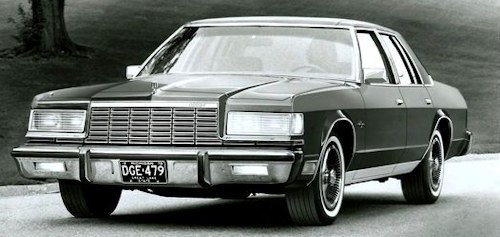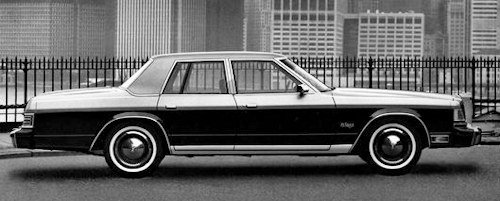Dodge St. Regis
 |
|
|
Production period: |
1979 to 1981 |
|
Class : |
luxury car |
|
Total Production |
64,502 |
|
Body versions : |
limousine |
|
Engines: |
Gasoline : 3.7-5.9 liters (63-146 kW) |
|
Width: |
1958 mm |
|
Height: |
1384 mm |
|
Curb weight : |
1601-1653 kg |
The Dodge St. Regis was offered by the US car manufacturer Dodge from 1978 to 1981.
History
The Dodge St. Regis was a full-size sedan. The St. Regis was presented for the model year 1979 as a successor to the 1977 Dodge Royal Monaco . To document the autonomy of the model, took over the new Dodge not the model name of the predecessor, but used a seemingly new name. In fact, however, the name St. Regis had been used since the 1950s in various contexts by the Chrysler Group. Thus, in 1955, a special model of the Chrysler New Yorker had the name St. Regis; later became the name of the corporate brand DeSoto.
Technically, the St. Regis could only partially be regarded as a new development. It was based on the so-called R platform of the Chrysler Corporation, which in turn was a modification of the introduced in 1970 "B-Body". This was related to the previous Intermediate models of the Chrysler Group, which included, for example, the Dodge Coronet , the Chrysler Cordoba and the Dodge Magnum XE . The recourse to this well-known platform meant that the top model of the brand had significantly smaller dimensions than its predecessor. This so-called downsizing, the competitive brands with the Chevrolet Caprice or the Ford LTD A few years earlier, Chrysler Corporation, which was in a deep structural and financial crisis in the 1970s, was able to move quickly through its platform strategy without much development effort.
The body of the St. Regis was redesigned. The passenger compartment, glass units, doors and fenders were identical to the simultaneously featured Chrysler Newport and Chrysler New Yorker ; also the one year later presented Plymouth Gran Furyused these structures. The individual models differed, apart from deviating laced equipment packages, solely by the design of the front and the rear end. The Chrysler Newport and the Plymouth Gran Fury were largely identical to this extent; however, the Dodge St. Regis had an independent front end. A special feature of the Dodge were the retractable Plexiglas covers in front of the headlights. Dodge had already realized this concept in 1978 with the Magnum XE; it should give the impression that the car had sporty broadband headlights, which were actually not allowed in the US. Therefore, the cover folded down upon activation of the square lights positioned behind here. The folding mechanism was also used on the brand's top model, the Chrysler New Yorker, used; There, the cover was not transparent, but painted in body color.
The only available as a four-door sedan St. Regis was powered by different engines. The base engine was a 3.7-liter inline six-cylinder with 110 hp. On request, a V8 engine with 5.2 liters and 135 hp was available; In addition, in the first two years of production, a 5.9-liter eight-cylinder engine with 150 hp (twin carburettor) or 195 hp (quadruple carburettor) could be ordered. A three-speed TorqueFlite automatic was standard equipment at every engine stage.
The selling price of the St. Regis was slightly lower than that of the largely identical Chrysler Newport. The base price of the St. Regis in 1979 was $ 6,532, $ 7,100 in 1980 and $ 7,737 in 1981. The time-delayed presented Plymouth Gran Fury was at significantly reduced equipment about $ 400 cheaper.
The Dodge St. Regis was just like the other models of the R-Body on the market unsuccessful. Although implemented Dodge with him a downsizing; However, he came two years too late compared to the equally smaller top models of competing brands. When it was finally introduced, it already seemed too big again. Since the introduction of the relatively large and thirsty St. Regis coincided with the so-called second oil crisis of 1979, their sales was limited. After the first model year, he was almost only bought by authorities and other fleet customers. For this reason, the St. Regis was taken back in the spring of 1981 from the market.
In two and a half years Dodge of the St. Regis dropped a total of just over 64,000 copies. His successor was the even smaller, based on the outdated M platform Dodge Diplomat .

Technical
-
Dodge St. Regis Technical details and specifications (1979-1981)
79 St. Regis
80 St. Regis
81 St. Regis
Engine (cid)
360
360
318
HP, SAE
195 bhp
185 bhp
165 bhp
Axle ratio
3.21:1
2.94:1
2.94:1
Weight (lbs)
4,530
4,100
4,086
Wheelbase (in)
118.5
118.5
118.5
Road course lap time
91.65
91.8
93.93
0–60 mph
10.1
11.3
12.76
0–100 mph
30.2
36.7
45.72
Top Speed, mph
122.9
122.7
114.7
Braking, ft/sec2
21.4
23.5
23.67
1/4 mi. time
NA
18.4
19.63
1/4 mi speed
NA
77.5
74.50
Fuel, EPA city
12
11
15.5
